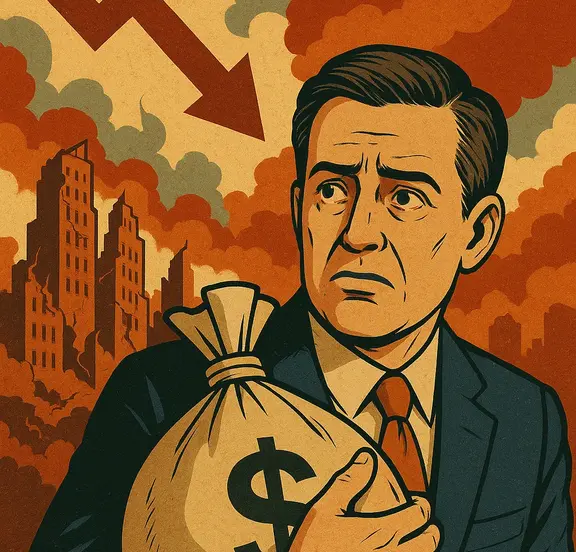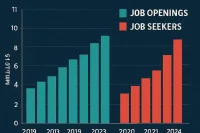Survive the coming collapse — the $37 trillion reality check
Survive the coming collapse — these aren’t just fear-mongering words, but a critical reality check for anyone with a 401k, savings account, stocks, bonds, or even cash sitting in the bank. America’s debt crisis has reached a breaking point that could either protect your wealth or leave you devastated by 2026. According to recent US Treasury data, America’s national debt has hit approximately $37.5 trillion, representing about $110,000 for every single American, man, woman, and child.
The Federal Reserve is cutting interest rates while inflation sits at almost 3%, and the government is paying $3 billion in interest every single day. This is not sustainable, and the wealth transfer is already happening. Understanding how to survive the coming collapse isn’t about panic—it’s about positioning yourself on the winning side of the inevitable economic reset.
The $37 trillion debt trap and why we’re past the point of no return
To put America’s debt crisis in perspective, the national debt represents $110,000 for every American, meaning the average household has $283,000 in debt. This is like owing more than five times the median household income. What makes this situation particularly dangerous is that the US debt-to-GDP ratio has reached 118%, meaning the US owes more than the entire economy produces in a year.
The last time the US was at these levels was during World War II, but back then, the US was the world’s manufacturer and creditor. Now, the US is the world’s biggest debtor. The $3 billion in interest payments every day translates to $80 billion per month and nearly $1 trillion per year—money that could rebuild every bridge in America, fund education, or provide healthcare, but instead goes to bondholders.
Imagine if your personal credit card bill was 118% of your annual income. If you make $60,000 per year but owe $71,000 on your credit card, and you’re only making minimum payments that eat up 18% of your paycheck, you can’t cut expenses enough to fix the problem or earn your way out of it fast enough. You have three options: default, go bankrupt, or inflate your way out by devaluing the currency. Governments always choose the third option.
The historical pattern of wealth transfer through inflation
This isn’t the first time America has faced such a crisis, and the pattern is clear throughout history. In 1971, Nixon faced a similar problem when the US had promised to back every dollar with gold but printed way more dollars than they had gold reserves. Nixon ended the gold standard, the dollar lost value, and within decades, gold went from $35 to $800 to over $5,000 today. Inflation hit 13% in the 1980s, destroying cash holders while asset holders not only preserved but grew their wealth.
The 1989 Latin American debt crisis saw countries owing hundreds of billions they couldn’t repay. The solution was the Brady Plan—debt restructuring that inflated away the debt by making currencies worthless. Asset holders won; cash holders lost. The 2008 financial crisis saw the Fed print trillions through quantitative easing. From 2009 to 2020, the S&P 500 made investors 400%, while cash in savings accounts lost purchasing power every year to inflation.
The pattern is clear: every time governments face unsustainable debt, they choose inflation over default. They devalue the currency, creating a massive wealth transfer from people who hold cash (savers) to people who own assets like stocks and real estate. We’re at that point again, except this time the US dollar is the world’s reserve currency, making the consequences even more severe.
Why traditional solutions won’t work
The traditional solutions that might seem logical simply won’t work in practice. Austerity measures—slashing spending and cutting government programs—will never happen because no one will vote for them. Try cutting Social Security and see what happens to your political career. Plus, austerity leads to recessions, which makes the debt problem worse as the economy shrinks.
Defaulting on the debt would destroy not just the dollar but the entire US economy overnight, tanking global markets. It’s mutually assured destruction because every country in the world holds dollar assets. Taxing your way out would require taxing 100% of income from the top 1% for years just to make a dent, and they would all leave by day two.
The Trump plan of growing your way out would require about 10% GDP growth for decades, which is never going to happen. The reality is there’s no traditional way out of this debt trap. There is only one path that actually makes sense: a controlled monetary reset using inflation.
The secret mechanism of wealth transfer
The mechanism works like this: The government issues bonds to borrow money, which are bought by the Fed, foreign governments, pension funds, and regular investors. Since the government can’t repay this debt through traditional means, the Fed keeps interest rates relatively low and allows inflation to run above their 2% target.
With inflation at 3% and savings accounts paying 0.5%, you’re losing 2.5% purchasing power every year. Over 10 years, you’ve lost 25% of your wealth. Meanwhile, the same inflation erodes the real value of the government’s debt, allowing them to pay back with cheaper dollars.
Asset prices—stocks, real estate, gold—inflate because there’s more money chasing the same assets. They go up not because they’re worth more, but because the dollar is worth less. This creates a wealth transfer from cash holders (salaried workers) to asset holders (investors).
Who wins and who loses in the wealth transfer
The wealth transfer creates two distinct groups. Cash holders, who are primarily salaried workers with full-time jobs, get poorer every year as their purchasing power erodes. Asset holders, who own real estate, stocks, and commodities, not only preserve their wealth but grow it as the government inflates away its debt.
This isn’t theory—it’s exactly what happened after 2008, after the pandemic, and after every major money printing event. In 2008, the Fed’s balance sheet was $800 billion. By 2014, it was $4.8 trillion. They printed $3.7 trillion, and from that crisis to COVID, the S&P made investors 400%.
This is essentially a hidden tax that hits the poor and middle class hardest because they hold most of their wealth in cash and get paid by salaries rather than investments. If you have $100,000 in cash with 3% inflation, you lose $3,000 per year. Over 10 years, that $100,000 becomes just $74,000—a loss of over $25,000 or 25% of your wealth.
How to position yourself on the winning side
The key to surviving the coming collapse is understanding what to own and what to avoid. Focus on assets that benefit from inflation and have pricing power. Tech companies like Microsoft, Apple, and Nvidia can raise prices and maintain margins. Energy companies will raise their bills, and banks benefit from higher interest rates on loans.
Commodities, particularly gold and silver, tend to perform well during inflationary periods. Defense contractors can charge more because no one questions ammunition prices during war. Healthcare companies have pricing power because people will pay whatever it takes when they’re sick. Utilities maintain pricing power because people need electricity and air conditioning.
Consumer staples with powerful brands, like Pepsi, can raise prices because people are addicted to their products. During COVID, these companies raised prices and people accepted it. The key is to own businesses that can pass inflation costs to consumers.
What to avoid during the collapse
Avoid speculation and overvalued assets. Meme stocks, some crypto gambles, and tech stocks with stretched valuations depending on your risk profile should be approached cautiously. While tech isn’t necessarily bad, there are other opportunities that may be more attractive.
Get rid of all leverage—margin calls are the ultimate disaster during market volatility. Understand your tax planning, as investing in a Roth IRA might provide better outcomes than following the herd. Most importantly, don’t follow the crowd buying whatever the latest trend is, because Wall Street has likely already bought it and is telling you about it so they can sell while you’re buying.
Build Stability When Markets Collapse
Avoid risky speculation and uncertain investments—focus on what truly lasts: meaningful careers and resilient teams. Post your job on WhatJobs today and connect with skilled professionals ready to bring stability and growth to your business.
Post a Job Free for 30 Days →The mathematics of wealth preservation
The math is clear: if you have $100,000 and stick it in the S&P 500 with a conservative 7% annual return (the market has done 10% over 30 years and 12% over the last 10), that $100,000 becomes $198,000 through the power of compound growth. Even adjusting for 3% inflation, you still have $146,000—50% better off than the cash holder who lost 25%.
The choice is stark: you can either get poorer by not being invested and holding cash, or you can get richer by being invested responsibly. There really is no choice—you must be in assets because you won’t get the salary increases you need, and your cash will lose tremendous value.
The role of education and skill development
The crucial skill isn’t just picking what to buy—it’s knowing when to sell. That’s what separates retail investors from professionals. Understanding position sizing, timelines, liquidity needs, and rebalancing strategies is essential for navigating the coming economic reset.
The dollar has already lost significant value this year, and this is intentional. They will keep doing it because it’s the only way to deal with the debt. The question isn’t whether this will happen—it’s which side of the transfer you’ll be on.
Building a resilient portfolio for the collapse
A resilient portfolio should include a mix of assets that benefit from inflation. Start with stocks or ETFs of companies with pricing power—tech companies, energy companies, banks, defense contractors, healthcare, utilities, and consumer staples with strong brands.
Commodities, particularly precious metals, should be part of your portfolio. Energy and agriculture commodities tend to perform well during inflationary periods. The key is diversification and understanding that different assets perform at different times.
The importance of timing and discipline
Timing matters, but discipline matters more. The goal isn’t to time the market perfectly but to be positioned correctly for the long-term trend. This means staying invested through volatility and not getting scared out of the market by short-term fluctuations.
The whole point of fear-mongering is often to scare you out of investing. The opposite approach—being invested responsibly, guided, educated, and skilled—is the path to wealth preservation and growth during the coming collapse.
The global implications of America’s debt crisis
America’s debt crisis isn’t just a domestic problem—it has global implications. As the world’s reserve currency, the dollar’s devaluation affects every country that holds dollar assets. This creates a complex web of economic relationships that make the situation even more challenging to resolve.
The wealth transfer mechanism works globally, with countries that hold significant dollar reserves potentially facing their own economic challenges. This interconnected system means that America’s debt crisis could trigger broader global economic instability.
Preparing for the inevitable reset
The coming economic reset is inevitable, but it doesn’t have to be devastating for those who prepare. The key is understanding the mechanisms at work and positioning yourself accordingly. This means moving from being a cash holder to being an asset holder, from being a saver to being an investor.
The reset will likely involve higher inflation, currency devaluation, and significant wealth redistribution. Those who understand these dynamics and position themselves correctly will not only survive but thrive during the transition.
The moral imperative of wealth protection
Protecting your wealth isn’t just about personal gain—it’s about being able to help others who don’t understand how the system works. When you’re financially secure, you can make a positive impact on your community and help those who are struggling.
The current system is designed to transfer wealth from the many to the few, but education and proper positioning can help level the playing field. By understanding these mechanisms and acting accordingly, you can protect not just yourself but also help others navigate the coming economic challenges.
The urgency of action
Time is of the essence. The wealth transfer is already happening, and the longer you wait to position yourself correctly, the more wealth you’ll lose to inflation and currency devaluation. The dollar has already lost significant value, and this trend will continue.
The choice is clear: you can either be part of the wealth transfer from cash holders to asset holders, or you can be a victim of it. There is no middle ground, and there is no time to waste.
FAQs
Q: What is the main cause of the coming economic collapse?
A: The main cause is America’s $37.5 trillion national debt, representing 118% of GDP, combined with unsustainable interest payments of $3 billion daily and the Federal Reserve’s policy of allowing inflation to run above target to inflate away the debt.
Q: How can I survive the coming collapse and protect my wealth?
A: To survive the coming collapse, you must transition from being a cash holder to an asset holder by investing in stocks, real estate, commodities, and other assets that benefit from inflation and have pricing power, while avoiding speculation and overvalued assets.
Q: Why won’t traditional solutions like austerity or tax increases work?
A: Traditional solutions won’t work because austerity measures are politically impossible (no one votes for cuts to Social Security), defaulting would destroy the global economy, and tax increases would require confiscating 100% of income from the top 1% for years.
Q: What assets should I own to survive the coming collapse?
A: Focus on assets with pricing power: tech companies (Microsoft, Apple, Nvidia), energy companies, banks, defense contractors, healthcare, utilities, consumer staples with strong brands, and commodities like gold and silver that perform well during inflation.
Live example — user point of view
I was a typical middle-class worker with $50,000 in savings and a 401k when I first learned about the coming economic collapse. Like most people, I thought keeping money in the bank was the safe option. But after understanding how inflation works as a hidden tax, I realized I was slowly getting poorer every year.
I started by moving my emergency fund into a high-yield savings account, but even at 4% interest, with 3% inflation, I was only earning 1% real return. The real wake-up call came when I calculated that my $50,000 would be worth only $37,000 in purchasing power after 10 years of 3% inflation.
I began investing in a diversified portfolio of stocks with pricing power—tech companies, energy stocks, and consumer staples. I also added some gold and silver ETFs to hedge against currency devaluation. Within two years, my portfolio had grown significantly, not just in nominal terms but in real purchasing power.
The key was understanding that the government will inflate away its debt, and I needed to be on the asset-holding side of that transfer. Now I’m not just preserving my wealth but growing it, while my friends who kept everything in cash are watching their purchasing power erode year after year. The coming collapse isn’t something to fear—it’s an opportunity to position yourself correctly if you understand the mechanisms at work.




